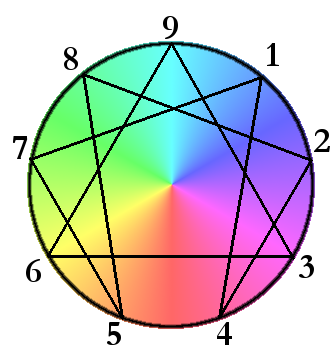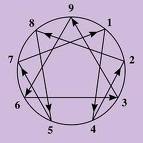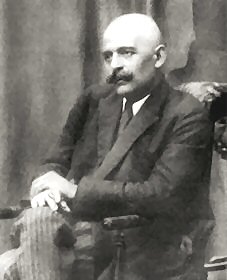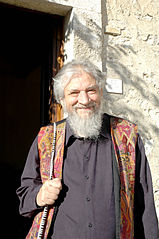 The enneagram, one of the hottest New Age gimmicks, is a personality-typing system often used in spiritual direction and for self-knowledge. People use it to identify their character type, then take steps to improve their personality, spiritual life, etc. But is this a good idea?
The enneagram, one of the hottest New Age gimmicks, is a personality-typing system often used in spiritual direction and for self-knowledge. People use it to identify their character type, then take steps to improve their personality, spiritual life, etc. But is this a good idea?In a word - no.
The enneagram comes from the Greek word “ennea” which means nine and “gramma” which means line drawing. The enneagram symbol is a circle surrounding a nine pointed star upon which nine human personality types are symbolically represented at equally distant points on the circumference. These numbers are then connected by arrows in significant patterns which supposedly point the way to health (integration) or neurosis (disintegration). Each one of the Enneagram numbers also has its own totem animal. The types/animals line up like this:
1. Perfectionist/reformer – terrier 2. Helper – cat 3. Status-seeker – peacock 4. Artist – basset hound 5. Thinker – fox 6. Loyalist – rabbit 7. Fun loving/generalist – monkey 8. Powerful – rhinoceros 9. Peacemaker – elephant
Although it might sound more like a child’s game, this personality-typing system is taken very seriously by proponents and can be found in parish workshops and even some seminaries across the country. And because it is so often used in spiritual direction, it received a strong warning from the Pontifical Councils for Culture and Interreligious Dialogue in the document, Jesus Christ, the Bearer of the Water of Life.
“. . . (T)he enneagram, the nine-type tool for character analysis, which when used as a means of spiritual growth introduces an ambiguity in the doctrine and the life of the Christian faith.”
The enneagram came from the Sufi religion and was introduced to the west by an Armenian occultist named George Ivanovitch Gurdjieff, who lived in Russia from 1877 to 1947. He attended the seminary as a boy but left at the age of 13 to pursue the occult, in which he was deeply involved for the rest of his life. During his travels through Egypt, India and Tibet, he came across a group of Sufis (Muslim mystics) who lived in Central Asia, from whom he learned the enneagram. They had been using it for fortune telling through numerology and as a symbol of the nine stages of enlightenment rather than the nine personality types ascribed to it in the west. Gurdjieff believed the enneagram was a universal symbol containing secret powers, and it was he who brought the symbol to the west.
It was another man, Oscar Ichazo, a Chilean occultist, who adapted the enneagram to its present use after learning it from one of Gurdjieff’s disciples. Ichazo is responsible for developing the system of nine personality types that it now contains.
Ichazo’s history is perhaps even more disturbing than Gurdjieff’s. “At the age of six he began having out-of-body experiences, which led to his disillusionment with the church,” writes New Age expert and former enneagram enthusiast, Father Mitch Pacwa in his book, Catholics and the New Age. “He could not accept Catholic teaching on heaven or hell because he had been there and knew more about it than Christ and the church.”
To gain control of his own consciousness, Ichazo studied Oriental martial arts, Zen, Andes Indian thought, shamanism, yoga, hypnotism and psychology. He joined esoteric groups in Bolivia and Argentina, and traveled to Hong Kong, India and Tibet to study mysticism.
He claims to have received instructions from a higher entity called “Metatron, the prince of the archangels.” Members of his group contact lower spirits through meditation and mantras, and are guided by an internal master, known as the Green Qu’Tub, who makes himself known when a student reaches a sufficiently high stage of development.
Another principal player in the advent of the enneagram in the west was another Chilean, Claudio Naranjo, who was living in America. He met Ichazo while on a visit to Chile and became fascinated with the enneagram. It was Naranjo who placed the psychological concepts into the enneagram. The two taught a course on the enneagram to Americans in Chile around 1969, after which Naranjo returned to the popular New Age community known as the Esalen Institute in Big Sur, California.
From Esalen, Naranjo established a nationwide network of small Enneagram groups. Among his early students was Father Robert Ochs, S.J. by whom Father Pacwa was taught at Chicago’s Loyola University. From there, it quickly spread among Jesuits, other religious orders, and into the general community.
Many instructors of the enneagram, including Ichazo and Gurdjieff, claim its roots go back as far as Mesopotamia in 2500 BC but the only historic evidence Father Pacwa could find for the enneagram goes back no further than the 1960's.
The Sufi and occult origins of the enneagram are generally unknown to many Christians because it is bathed in Christian sounding language. As this blog explains, the dissident priest, Father Richard Rohr, has even tried to Christianize these roots. But don't be fooled by these attempts to disguise the truth.
“Catholics using the enneagram talk about things like saints and sin and faith and ‘fruits of the spirit’,” writes Catholic author Rick Kephart. “Using these words makes it sound legitimate. But they are only adapting these terms to the enneagram, by giving them different definitions.”
For instance, “sainthood” in the enneagram has nothing to do with holiness. It has to do with the Sufi meaning of saint, which is a person who is illuminated to Reality. Therefore, in the language of the enneagram, a saint is someone who “overcomes his false self and knows and acts according to his true self.”
 Sin is another word that is bantered around in the world of the enneagram, but has a completely different meaning than what Catholics understand it to mean. Sin does not mean breaking God’s law; it means the various “personality traits that separate people from God or their true selves,” Kephart writes.
Sin is another word that is bantered around in the world of the enneagram, but has a completely different meaning than what Catholics understand it to mean. Sin does not mean breaking God’s law; it means the various “personality traits that separate people from God or their true selves,” Kephart writes.
“Sin is the sinister motivation everybody has for everything they do. It must be accepted and brought under control. The number assigned to a person by the enneagram indicates what their ‘root sin’ is and will always be. ‘Sin’ is also called ‘addiction’.”
Fruits of the spirit in the language of the enneagram have nothing to do with the Holy Spirit. “In the enneagram, the fruits of the spirit are good inclinations a person gets according to his number in the enneagram. The ‘Holy Spirit’ according to the enneagram is not a Person at all: He is a synonym for ‘power’ or ‘energy’ in Enneagram spirituality . . .”
Redemption has nothing to do with Christ. Instead, redemption is “the same as maturity, which is what they call freedom from one’s ‘false self’ to one’s ‘true self’. This true self is also called the ‘soul’, another redefined word.”
These subtle disguises can fool even the most well-intentioned proponent of the enneagram. “Taking words from our religion and changing their meanings can give things, even an entirely different religion, the outward appearance of being Catholic. Some people are satisfied that something is good just because they hear a Christian vocabulary being used. That makes the slip into apostasy very gentle and painless.”
In spite of the fact that the enneagram is a scientifically untested system, it is also being used to help people deal with personality disorders.
“Unlike some ‘personality type indices’ the enneagram remains untested by any scientific study,” writes Christopher Rees for Homiletics and Pastoral Review. “Like Sufism, the ‘dynamisms’ adopted in each of the nine ‘types’ depends on which guru or shaikh you prefer. There are as many ways of constructing groups and interpreting the enneagram as there are gurus. So the only apparent similarity the enneagram shares with behavioral sciences is its lack of a paradigm.”
Because the Enneagram has descriptions that read like those for esoteric systems like tarot, astrology, biorhythms, etc., advocacy of the enneagram is even more problematic for Catholics, Rees writes.
“. . . The Gnostic [salvation through knowledge] roots manifest in all enneagram systems guarantee that enneagram systems can never be reconciled with the Sacred Deposit of Faith.”
The mixture of so many non-Christian and occult elements in the enneagram, combined with its utter lack of scientific validity, should warn people away from its use.
“No tests, no standards, no board of examination exists, so most enneagram ‘experts’ have that title through self-declaration and workshop advertising,” writes Father Pacwa.
“People do not go to doctors and psychologists unless that practitioner is tested and licensed. Should not some similar requirement be made of enneagram teachers, who not only explain what your personality is like, but make recommendations about what you should be like?
“Until such verification of the enneagram occurs, resulting in ways to discern who has enneagram expertise, I recommend that people not patronize the workshops, seminars and retreats.”
© All Rights Reserved, Living His Life Abundantly®/Women of Grace® http://www.womenofgrace.com


